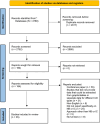A systematic review of the patient reported outcomes that affect patients with muscle invasive bladder cancer after radical cystectomy and urinary diversion
- PMID: 38873348
- PMCID: PMC11168771
- DOI: 10.1002/bco2.339
A systematic review of the patient reported outcomes that affect patients with muscle invasive bladder cancer after radical cystectomy and urinary diversion
Erratum in
-
Erratum.BJUI Compass. 2024 Dec 30;5(12):1324-1329. doi: 10.1002/bco2.482. eCollection 2024 Dec. BJUI Compass. 2024. PMID: 39744071 Free PMC article.
Abstract
Objectives: To determine the functional domains and symptom scales that affect patients most following radical cystectomy (RC) and urinary diversion (UD), and if a single instrument (or combination) adequately captures these bothersome symptoms. It is unclear whether current patient reported outcome (PRO) instruments that have been used to assess quality of life in patients following RC and UD adequately cover the most bothersome symptoms affecting patients.
Materials and methods: A systematic search of MEDLINE, EMBASE, PubMed, Cinahl and Cochrane was conducted from January 2000 to May 2023 for original articles of patients who had RC and UD since 2000 for muscle invasive bladder cancer. The Preferred Reporting Items for Systematic Reviews and Meta-Analyses (PRISMA) process was followed. Extracted data included the PRO measures used, domains reported and scores in the first 12 months post-surgery (short-term) and after 12 months (long-term). A conservative threshold of <70 for functional domains and >30 for symptom domains was used to determine which PRO domains were potentially concerning to patients in each study. Quality assessment was performed using the QUALSYST appraisal tool.
Results: Thirty-five studies met the inclusion criteria, including a total of eight unique PRO instruments. The main findings indicated that physical function was the most concerning PRO for patients with both neobladder (NB) and ileal conduit (IC) in the short and long term. Additionally, bowel, urinary and sexual bother were concerning symptoms for patients with NB in the long-term, but only in the short-term for those with IC.
Conclusions: The main issues are adequately addressed using the combination of EORTC QLQ-C30 and QLQ-BLM30 instruments.
Keywords: bladder; cystectomy; patient reported outcome; quality of life; radical cystectomy; urinary diversion.
© 2024 The Authors. BJUI Compass published by John Wiley & Sons Ltd on behalf of BJU International Company.
Conflict of interest statement
The authors have no interests to declare.
Figures
References
-
- Aaronson NK, Ahmedzai S, Bergman B, Bullinger M, Cull A, Duez NJ, et al. The European Organization for Research and Treatment of Cancer QLQ‐C30: a quality‐of‐life instrument for use in international clinical trials in oncology. J Natl Cancer Inst. 1993;85(5):365–376. 10.1093/jnci/85.5.365 - DOI - PubMed
-
- Colin Johnson NA, Blazeby JM, Bottomley A, Fayers P, Koller M, Kuliś D, et al. EORTC Quality of Life Group ‐ Guidelines for Developing Questionnaire Modules 2011; 4.
-
- Cookson MS, Dutta SC, Chang SS, Clark T, Smith JA, Wells N. Health related quality of life in patients treated with radical cystectomy and urinary diversion for urothelial carcinoma of the bladder: development and validation of a new disease specific questionnaire. Urol J. 2003;170(5):1926–1930. 10.1097/01.ju.0000092830.03247.ef - DOI - PubMed
Publication types
LinkOut - more resources
Full Text Sources
Miscellaneous

